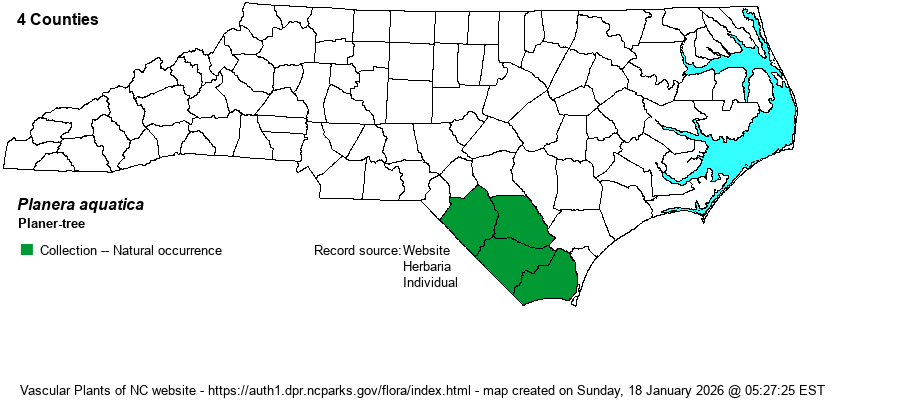| Author | (Walter) J.F. Gmelin | |
| Distribution | Restricted to the southeasternmost counties, only known from Bladen, Robeson, Columbus, and Brunswick counties -– along the Lumber and Waccamaw rivers (and tributaries).
This is a Coastal Plain species that ranges north only to southeastern NC along the Atlantic Coast but far up the Mississippi drainage to southern IL and eastern OK. It occurs south to northern FL and eastern TX.
| |
| Abundance | Though not a widespread tree in the state, it is actually fairly common along the immediate shorelines of the Lumber River, at least below Lumberton, and the Waccamaw River. It seldom occurs away from the banks of the rivers, and trees often lean over the water. In late 2024, the NCNHP placed the species back onto its Watch List, as its State Rank is a scarce S1S2. | |
| Habitat | The species occurs essentially only along the banks of blackwater rivers (in NC); it can occur in some flooded areas back from the river, but this is mainly a habitat south of NC. | |
| Phenology | Flowers in March and April; fruits extremely early -– April into May (of the same year). | |
| Identification | This is a rather small deciduous tree, growing to about 40 feet tall, rarely to 50 feet. If it grew scattered over the state, it could be overlooked as a Winged Elm (Ulmus alata), as both have quite small, strongly serrated leaves. However, when one is doing field work in the Lumber and Waccamaw rivers area, it is not hard to find and identify, as the tree typically grows right next to the water. The alternate leaves are only about 2.5 inches long and lanceolate to narrowly ovate; the elm’s leaves are elliptic in shape. One might confuse American Hornbeam (Carpinus caroliniana) with Planera, as both grow along the banks of blackwater rivers and have rather small leaves; however, that species has leaves that are never lanceolate or ovate (obviously wider below the middle). The flowers are quite small and occur in axillary clusters; however, the fruit are unique, looking like very small pine cones, perhaps less than 1/2-inch long and wide. The trees can often be found growing in shallow water. Many biologists are perhaps not familiar with the species, as it has a narrow range in the state and as there are no other species in its genus; the flowers and fruit are small enough that they do not command attention, either. Nonetheless, monotypic species like Planera should always be appreciated for their uniqueness. | |
| Taxonomic Comments | None. This is the only species in its genus.
| |
| Other Common Name(s) | Water Elm (or better Water-elm) is often used, though it is not a true elm; however, it is related to them in the Family Ulmaceae. | |
| State Rank | S1S2 | |
| Global Rank | G5 | |
| State Status | W1 | |
| US Status | | |
| USACE-agcp | OBL link |
| USACE-emp | OBL link |

